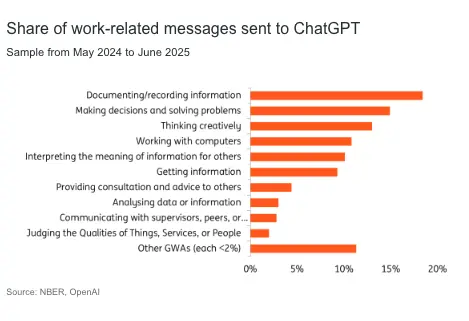10% of the world's population now uses ChatGPT
A recent publication by OpenAI reported that the number of users ChatGPT sees each week is now around 700 million, which translates to roughly 10% of the world population. With a deployment that vast, GenAI is not only being increasingly adopted in enterprises but is also becoming a part of our everyday lives. In June 2024, 53% of the messages were non-work-related, which in June 2025 stands at 73%, leaving 27% categorised as work-related messages.
77% of the conversations are reported being used for practical guidance (29%), information seeking (24%), and writing (24%). However, when it comes to only work-related messages, it is largely used for writing (40%), practical guidance (24%) and technical help (10%).
AI-driven productivity gains vary depending on the nature of the task
Based on the output that the user wants to receive, the messages sent to ChatGPT can also be classified into three types: doing, asking and expressing. These have different economic implications. Doing messages – using ChatGPT to perform tasks such as writing, generating code, analysing data, etc. – produce directly usable output and can be seen as automation of tasks. Asking messages – seeking information to be better informed – help in supporting user decisions but do not directly produce output, serving as an augmentation tool. Expressing messages, which are neither for information seeking nor performing a task, contribute negligibly to productive output.
Currently, 35% of messages are doing related and 52% are asking, highlighting the dual role of ChatGPT as a co-worker producing output and a co-pilot aiding problem-solving. The most common tasks (shown in the figure below) can be combined into two main functions; a) gathering, documenting, analysing, and interpreting information, and b) thinking, solving problems and providing consultation. This shows that generative AI currently aids people with either the quality or speed of their work, which is a productivity improvement.

Usage patterns vary widely across demographic groups
Around its release, approximately 80% of active users of ChatGPT were men. Currently, usage is roughly balanced between men and women but there are differences in how they use it. Women tend to send mostly writing and practical guidance queries, while men tend to use it more for technical help, information seeking, and multimedia. The share of work-related messages also increases with age, education level, and for highly paid professional occupations. This suggests that GenAI might currently be providing more productivity benefits for users who already have access to better jobs and education, validating earlier concerns about its disproportionate impact. A recent Standford study in the US further supports this, by showing a decline in employment for early-career employees.
Benefits of AI could be distributed unevenly
The disparities in usage might suggest unequal benefits. Men tend to use GenAI at work for tasks centred around asking - such as information seeking - reflecting a more augmented, decision-supported role for AI. In contrast, women more often use AI for doing tasks like writing, which are more closely linked to automation and have a higher risk of replacement. Moreover, highly educated employed users stand to gain more, while opportunities for junior employees could be limited.
This makes us think about something Nvidia CEO Jensen Huang’s said recently: “You’re not going to lose your job to AI, you’re going to lose your job to someone who uses AI.” While embracing this technology offers clear productivity gains, those who use it best will have a distinct advantage.





















































































